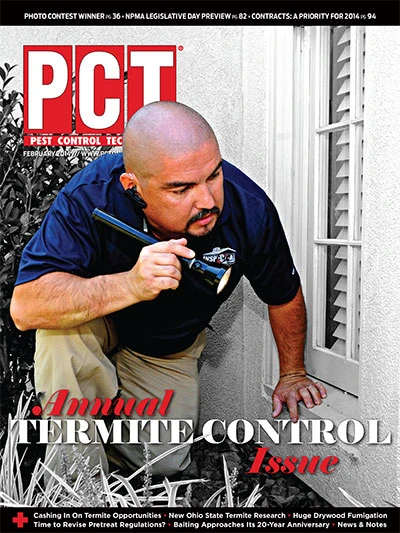 The good news: You landed a 10-million-cubic-foot termite fumigation job. The bad news? The entire job — a 14-building condominium complex with 530 units and 11 underground garages — has to be completed in a single day. Wait — what?
The good news: You landed a 10-million-cubic-foot termite fumigation job. The bad news? The entire job — a 14-building condominium complex with 530 units and 11 underground garages — has to be completed in a single day. Wait — what?
That was the opportunity and challenge facing Willie Payne, founder and president of Payne Pest Management, after he agreed to rid the Lakeside Village development in Culver City, Calif., of its recurrent drywood termite infestations. No stranger to large fumigation jobs (his record is an 18-million-cubic-foot project at Marina Pacifica in Long Beach, Calif.), Payne had no worries about the size of the job. What gave him a moment of pause was the time constraint.
“Our initial plan was to treat building by building,” he explains, “but when the local gas company came in to assess the situation, they told us that there was no way to isolate the gas. The complex was built 45 years ago with low-pressure gas lines that couldn’t be turned off one building at a time. Everything’s connected. Our only option became doing the whole job at once — in one day so that residents wouldn’t be out of their homes for too long. We had never done such a large project in such a short time frame. In fact, I don’t think anyone in the state had.”
Making matters worse: The gas company’s inspection revealed 400 leaks underground and in the walls that the property manager had to address before Payne’s team could begin. Those repairs put the job nine months behind schedule. But the delay gave Payne ample time to plan. He recruited Manuel Aguilar and his two fumigation firms, Your Way Fumigation and Dr. Fume. “We had worked with Manny on a number of projects, and I knew that, in addition to having the manpower and equipment to cover 10 million cubes, he shares my philosophy of doing the job right the first time,” says Payne. “For this project, getting it right the first time was critical. You do not want a do-over.”
Onsite Effort.
Pulling this project together and monitoring all the people on the job was a tremendous undertaking: In addition to the teams from Payne, Your Way, Dr. Fume and JC Fumigation (a company Aguilar recruited as a measure of insurance that there would be plenty of fumigation technicians on-site), Payne was charged with coordinating the efforts of security guards, locksmiths and gas company representatives. In all, 62 professionals contributed to the project, whether inspecting the building, supervising and implementing the evacuation, or carrying out the fumigation itself.
“I facilitated the collaborative effort, making sure there was open communication among all parties from start to finish,” says Payne. “We got great support from the homeowners’ board of directors, who gave me the opportunity to meet face-to-face with residents. Of course, I also kept in close touch with all of our subcontractors. Communication was a key component of our success.”
Planning was the other vital component. “A job of this size — particularly one that has to be completed so quickly — requires flawless planning. The job was to be completed on Monday night, and the residents needed to be back in their units by 3 p.m. Wednesday,” says Aguilar. “We started the outdoor preparations on Saturday and Sunday. On Monday, we evacuated the residents. That was possibly our biggest challenge.”
| The Special Challenges of Drywood Termites Drywood termites live mainly in the South and differ from their subterranean counterparts in that they require no moisture and never leave the dry wood members upon which they feed (they build their colonies in structural wood). These behaviors limit the number of effective management solutions since direct contact with the pest is necessary. For the Culver City condo project, PMP Willie Payne said he chose fumigation because too many walls within the complex had been infested for a local approach to be effective. He determined that the best way to eradicate these infestations was to permeate the wall spaces with a gas fumigant so that no colony was left untouched. |
The sheer number of residents was a challenge made worse by the fact that about half of them didn’t prepare according to the guidelines Payne issued. Having met with residents weeks prior to the fumigation to explain what would be happening, he provided oral and written instructions detailing the steps residents needed to take. But when Payne and Aguilar’s teams went in to check each unit, they found that many residents had not prepared adequately.
“I assigned 28 people to customer service,” says Payne. “They did everything from moving heavy plants for elderly and physically challenged residents to helping residents appropriately bag or dispose of food. They also checked to ensure residents’ safety and prevent potential label violations.”
Payne’s son Jason, COO at Payne Pest Management, played an integral role in the evacuation as he led “Fume Central,” the supervisory office set up in the complex’s clubhouse from pre-evacuation through project completion.
Once the residents had been safely evacuated and the gas company had rechecked all lines, the project team put 40 cylinders of Dow AgroSciences’ Vikane gas fumigant to work. Aguilar’s team monitored the gas levels throughout the night, manning two motor homes that housed sensitive electronic equipment. They had installed gauges in each building to measure the amount of gas per thousand cubic feet and provide readings to the monitoring stations. “We recognized the critical nature of keeping the gas levels high yet safe across the buildings,” Aguilar says. “If one building fell short — if we failed to get the hit — then we would have do the entire job again. That was an expense and inconvenience no one wanted.”
Happy Ending.
Once the Vikane had done its job, the team worked to clear out the gas, shooting for the safety level of less than one part per million, which they achieved Wednesday morning. The L.A. County Department of Agriculture sent inspectors to begin testing buildings unit by unit at 11 a.m. that day. “We had only a few hours to test every unit,” says Aguilar. “But the process went amazingly well. Every reading was zero, and we cleared the final units 10 minutes before residents were scheduled to return.”
In fact, the team scored zeroes all around: Zero ppm, zero callbacks and zero complaints. “We finished the job on July 17, two weeks before the drywood swarm season started. The three-month season ended Nov. 1, and not a single termite has been reported. That’s huge given the complex had been plagued by swarms for years,” Payne says. “We are delighted with the results of this effort.”
The author is a frequent contributor to PCT.

Explore the February 2014 Issue
Check out more from this issue and find your next story to read.
Latest from Pest Control Technology
- Moneypenny is a Provider of Virtual Receptionists
- Video: Top 10 PCT Photo Contest Finalists
- Massey Services Expands with Southeast Commercial Region
- Pest Management Foundation Announces Kevin J. Burns Scholarship
- How to Identify Clover Mites
- Termite Threat Halted in Southern Florida
- PCT Media Group Adds Managing Editor Katie Hobbins
- Evens Clerjuste on Team Communication as Company Growth Point





